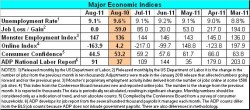 Job growth was a wash in August, with the U.S. economy adding 17,000 private, nonfarm sector jobs, but losing the same number of government jobs. That leaves the unemployment rate at 9.1 percent, according to the monthly job numbers released by the U.S. Labor Department this morning.
Job growth was a wash in August, with the U.S. economy adding 17,000 private, nonfarm sector jobs, but losing the same number of government jobs. That leaves the unemployment rate at 9.1 percent, according to the monthly job numbers released by the U.S. Labor Department this morning.
It was the weakest report since last September, when the nation lost 29,000 jobs. Few economists expected August to show much strength, but all but the most pessimistic expected some growth. Surveys by various financial services showed the average of the various estimates ranging from 75,000 to as high as 92,000 jobs.
Striking Verizon workers accounted for a significant part of the flat report. The 45,000 strikers pushed down the numbers in the information industry, which showed a loss of 48,000 jobs. The strikers have now returned to work, but even without a strike, the report would have been below estimates.
In addition, the government also revised downward the job numbers for June and July by a combined 58,000 positions, bringing the two month total to 105,000 jobs, not even close to the 250,000 to 300,000 new jobs needed monthly to make a dent in unemployment.
The report adds more pressure to the President and Congress to take action to bolster the flagging economy. Obama is scheduled to unveil a jobs plan next week that will likely include a continued cut in payroll taxes, incentives to hire workers, and a program to rebuild the nation’s infrastructure. The big question is whether Congress will go along.
However, as the flaccid recovery has mushed along, the ranks of the out of work, the long-term unemployed and the part-time workers haven’t improved. In August, the Labor Department says, there were 14 million out-of-work Americans, 6 million of whom have been out of a job for more than 6 months.
Another 2.6 million unemployed are considered marginally attached, meaning they’re out of work, have been looking for a job, but didn’t during the Labor Department’s survey period. Their numbers increased by 200,000 since last year.
Many who want full time work have turned to part-time jobs. Today’s report says 8.8 million are working part time because they have no other option, a rise of 400,000 in just one month.
What job growth there was came, as it has for months, in healthcare, which added 30,000 jobs during August. Another 8,000 jobs were added in computer systems and design, and mining added 6,000. Temporary help grew by 5,000.
Manufacturing, which had been adding jobs regularly and was helping to lead the recovery, declined in August, shedding 3,000 jobs. In the first four months of the year, the category added an average of 35,000 jobs each month. In the last four months, the job growth has shrunk to 14,000.
In another sign of stagnating growth, the average workweek for private, nonfarm workers dropped by .1 to 34.2 hours weekly. The manufacturing workweek was 40.3 hours, unchanged for the last three months, although overtime did increase by .1 hours to 3.2 hours. Production and nonsupervisory employees saw their hours decrease to 33.5 from the 33.6 average that had held for six months.
Average hourly earnings decreases slightly in August to $23.09, a drop of 3 cents over July. Over the past 12 months, average hourly earnings have increased by 1.9 percent.